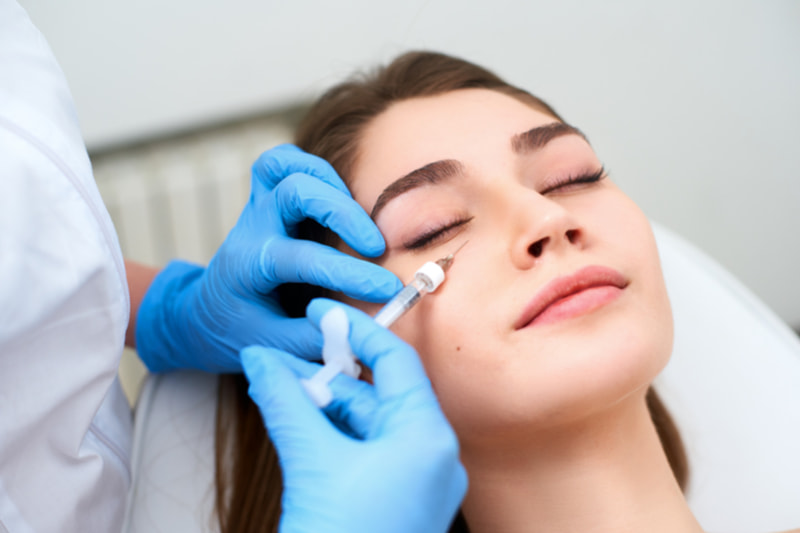
For many patients, treating the infraorbital hollows (IOH), or under-eyes, can make a positive impact on their overall facial appearance and move them closer to their aesthetic goals. Non-verbal cues from our faces help others to form positive or negative feelings about us. Under eye hollows can convey a tired and sad appearance to the outside world. In addition to contributing to a more youthful appearance, IOH treatment can restore lost volume under the eyes, reduce fine lines in the eye area, correct under eye dark circles, and balance the face.
Common Misconceptions About Correcting IOH
The biggest fear most patients have concerning filler is looking weird or unnatural. At beyond|AESTHETICS we avoid that by looking at the face as a whole and taking into consideration how one area affects the next as well as how any particular treatment will affect the overall facial shape. Patients often request a small amount of filler to maintain a natural-looking appearance. Unfortunately, filling only one area to correction while leaving other areas with a deficit is exactly why dermal fillers begin to look unnatural.
Natural Looking IOH Treatment
Recently Allergan Aesthetics gained FDA approval for JUVÉDERM Volbella in the IOH region. After extensive research on best practices, the best method for IOH correction starts with the cheek area using JUVÉDERM Voluma—something experienced injectors have long known. From an anatomical standpoint, a comprehensive approach that starts with injecting the cheek for structural support has been shown to indirectly improve the under eye.1
Not only do I see how impactful cheek treatment can be in my own practice but I recently attended Allergan’s Train the Trainer meeting in San Diego. We took a deep dive into the complex and specific anatomy and physiology of the infraorbital hollows with an in-person cadaver dissection of this area along with some amazing tips and tricks for filling here with predictable and consistent results.
The anatomy of the IOH region differs from other areas of the face in that there is less tissue and thus a smaller margin for error. A thorough understanding of local anatomy is needed by the aesthetic provider to effectively treat this area and achieve optimal results. If you are a provider, I highly recommend taking a cadaver course to enhance and/or solidify your knowledge of this area. The following are some anatomical considerations that the provider will assess when correcting the IOH area, which vary from patient to patient:
Skin Pigmentation
If the “dark circle” is truly caused by dark pigmentation vs. a hollow, you may not get as noticable of an improvement with filler. If you have both pigmentation AND hollowing due to volume loss, you will get an improvement but it may still look like there’s a shadow.
Skin Laxity
Severely lax or loose skin of the lower eyelid and IOH poses other aesthetic challenges such as not having a smooth transition from cheek to under eye which may require other types of treatment such as skin resurfacing, skin tightening, and medical-grade skincare products.
Orbital Fat Pad Prolapse
Everyone has an orbital retaining ligament that adheres to the skull and the fat sitting above the ligament can start to bulge over the ligament. This can create both a hill and a valley.
Assessing Infraorbital Hollows For OptimalCorrection
I begin my patient assessment before many of them realize it! I look at how the face moves with normal expression and I take note of any deficits or bulges, areas that pinch or pull, and my overall impression. I then have the patient tilt their head down to look for any IOH and cheek volume loss. With their head in a neutral position, I have the patient rotate side to side to look for any flattening of the cheeks and then have the patient look up to assess any fat pad protrusions. I also look at skin laxity and will do a pinch test to see how long it takes the skin to snap back into place. While not a comprehensive list of assessment techniques, this is a typical start to determining good candidates for IOH filler treatment.
In addition to a thorough assessment, we also take HIPAA-compliant clinical imaging of every patient prior to treatment and invite them to come back in 4-6 weeks for follow-up.
How The Cheeks Provide IOH Support
For patients who have volume loss in their cheek area, filling the IOH region alone might have poor or sub-par results, especially long term. If you don’t have sufficient structure in the cheek, filler injected into the IOH area doesn’t have the necessary support. At best, it may look good for perhaps a few months and then “disappear” much sooner than it should. Worst case scenario is the filler slips down against the orbital retaining ligament and looks like a bulge, which can happen within weeks.
How many syringes of filler does IOH treatment require?
The exact amount depends on your unique facial attributes and anatomy. Generally, patients see improvement with 2-4 Voluma for the cheek and 1 Volbella in the IOH. We have packages such as the Targeted Refresh and Structure Enhancement that make multi-syringe packages affordable and results-driven.
Learn More About Infraorbital Hollows Treatment
If you have questions about IOH treatment or our filler packages, please contact us today. We’d be happy to discuss details of IOH treatment over the phone or schedule a personal consultation where you’ll receive a treatment plan customized just for you.
1 Clin Cosmet Investig Dermatol. Management of Tear Trough with Hyaluronic Acid Fillers: A Clinical-Practice Dual Approach. Available: https://www.ncbi.nlm.nih.gov/pmc/articles/PMC8127324/. Accessed May 4, 2022.
